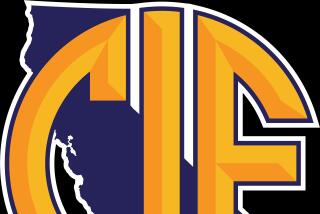NCAA Presidents Have Taken Another Stand : They Are Looking for an Improved Balance Between Academics and Athletics
- Share via
SAN DIEGO — Since its formation three years ago, the Presidents Commission has had a tremendous impact on the National Collegiate Athletic Assn., first with its insistence on rules enforcement that resulted in the “death penalty” and then with its insistence on higher academic standards that resulted in Proposition 48.
Now the Commission is focusing on balance.
In making the expected announcement of a special convention June 29-30 at Dallas, Chancellor John B. Slaughter of Maryland, who is chairman of the Commission, said, “We want to establish a balance between intercollegiate athletics and the other programs at our institutions, especially a better balance between athletics and academics.”
The Commission has established an ad hoc committee to develop legislation to be considered at the special convention. Chancellor Michael Heyman of California will head the committee that will present legislation in the areas of recruiting, coaches’ compensation, playing and practice seasons, coaching staff sizes and financial aid.
Much of the legislation on those topics that was to have been considered by the delegates to the NCAA convention being held here this week will now be withdrawn and referred to the committee.
Even some of the resolutions for cutbacks that are in line with the goals of the commission are likely to be withdrawn so that all similar legislation can be considered as a package in June.
So far, there has not been opposition to the plan for the special convention or for the changes that are expected. The chief executive officers seem to be determined to have it their way, and the coaches and athletic directors seem to be resigned to the inevitability of it all.
Members of the College Football Assn., in their meeting Tuesday afternoon, expressed some concern for how much input coaches and athletic directors would have in the special convention issues, but there was no sense of panic or urgency, no plan for threats or power plays.
Asked if he was concerned that the “superpowers” might be so strongly against a slate of cutbacks that they would again consider walking out, Heyman said, “That’s always a worry.” But he said that he had spoken with Nebraska Chancellor Martin Massengale, who is president of the CFA, and that they had agreed it would be better to stick together.
The phrase “cost containment” is being used to describe the nature of changes that could also be called cutbacks or de-emphasis or any number of terms that would indicate that college athletics will be scaling down.
Slaughter said, “We’re not talking about a de-emphasis, but a change in emphasis.” Heyman suggested that it be considered “sort of like mutual disarmament.”
By any translation, that means less instead of more. So, where would the chief executive officers stand on, say, the idea of a national football championship?
You guessed it. Heyman put it this way: “If nothing else, we need to put a cap on the momentum of where intercollegiate athletics is heading. It would be very unlikely there would be a playoff in 1-A football.”
And when the subject of freshman eligibility eventually becomes an issue again? Heyman and Slaughter, for starters, would favor letting freshmen use their first year to get used to being students and their next three years to becomestudent-athletes.
It’s all in the interest of balance.
The commission released a report outlining its position on proposed legislation at this convention and its approach to additional legislation.
On recruiting: The commission supports the resolutions that would exclude boosters from contacting recruits and would limit recruiting seasons. The commission asked that resolutions limiting the number and type of recruiting contacts be referred to its committee. And the commission directed the ad hoc committee also to consider the recruiting opportunities inherent in high school all-star games, sports camps and clinics.
On compensation of coaches: The commission supports, in principle, resolutions that would require coaches to report to their chief executive officers all sources of outside income including endorsements and shoe contracts.
On playing and practice seasons: The commission asked that resolutions to establish seasonal playing and practice limitations in all sports and resolutions to limit the number of baseball and softball games be referred to its committee.
On size of coaching staffs: The commission asked that resolutions to cut the number of football and basketball assistant coaches and resolutions to designate only three coaches who could recruit in basketball to the committee.
On financial aid: The commission asked that a series of resolutions concerning limits on how much money student-athletes could receive and how many grants-in-aid should be allowed be referred to its committee.
The commission’s position on financial aid included some interesting approaches, such as a section saying that one way to reduce the money spent on financial aid is “either to further limit . . . the number of grants-in-aid permitted in all sports or to further limit the number of grants-in-aid permitted in non-revenue-generating sports.” Another section said, “Whereas (We) believe that the most effective way of ensuring that NCAA member institutions administer grants-in-aid responsibly is to require that the number of grants-in-aid permitted in a sports be dependent on the graduation rate of student-athletes in that sport.” Just what kind of graduation rates would be established and how many scholarships might be lost in any sports, Heyman could not say.
The policy statement is just the starting point.
Heyman said, “Our approach is to try to reason from the general to the particular. We’re not experts. We don’t know whether spring practice should be none or 10 or 15 days.” But, somehow, they feel that there should be a limit, a control, an attempt to balance.
The details will be worked out, with help from surveys of coaches and athletic directors, in the next few months.
Heyman said, “We’re going to need an awful lot of help from people knowledgeable about intercollegiate athletics, from the coaches, from the NCAA Council, and others, but where to strike a balance is our job.”
More to Read
Go beyond the scoreboard
Get the latest on L.A.'s teams in the daily Sports Report newsletter.
You may occasionally receive promotional content from the Los Angeles Times.










